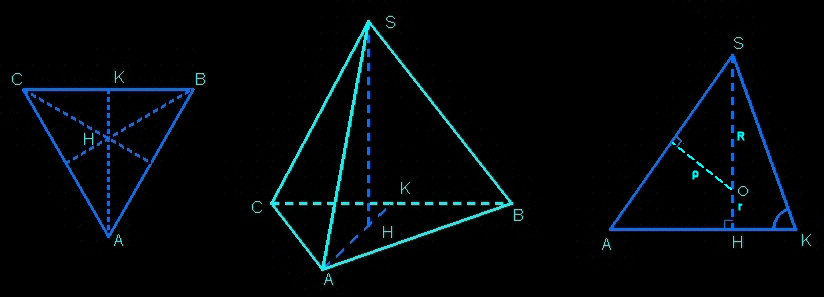
updated 30-03-2010

These results are neither obvious, nor known by heart (except by a few genius!); it is thus suitable to verify them.
We can compute the volume again by using the cube in which the tetrahedron is naturally inscribed.
The diagonal of a face is equal to a (edge of the tetrahedron), thus the edge of the cube is c=a/√2.
To get the tetrahedron we have to cut off four "corners" of the cube (tri-rectangular tetrahedra with equilateral base). If we use one of the isosceles-rectangular face as base, the hight of a "corner" is c, and its volume (1/3)×(c²/2)×c = c³/6
we deduce the tetrahedron's volume: c³-4(c³/6) = c³/3 = (a/√2)³/3 = (√2/12)×a³
Corollary 1: the hight of the tri-rectangular tetrahedron relative to the equilateral face is the third of the cube's diagonal (d=c√3).
From V = (1/3)×A×h we deduce h = 3V/A = 3[c³/6]/[(1/2)×(c√2)×(c√2)(√3/2)] = c/√3 = c√3/3 = d/3
Corollary 2: The circumsphere (defined by the four vertices) is, by symmetry, centered at the intersection point of the altitudes; its center O lays at the quarter of each altitude (starting from the base), its radius is thus R = (3/4)×h.
proofs: • O is the isobarycentre of the vertices O = bar[A(1),B(1),C(1),S(1)] = bar[bar[A(1),B(1),C(1)],S(1)] = bar[H(3),S(1)] situated at the quarter of HS
• One may also use the cube which has four vertices which define the tetrahedron; the two polyhedra have same circumsphere.
An altitude of the tetrahedron lays on a diagonal of the cube and h=(2/3)d thus R = d/2 = 1/2×(3/2)h = (3/4)×h
verification: a=c√2, d=c√3 and h=(2/3)d lead to R = d/2 = (3h/2)/2 = (3/4)×h or R = (c√3)/2 = ((a/√2)√3)/2 = a×(√6/4) = a(√2/√3)×(3/4) = h×(3/4)
remarks: radius of the insphere (tangent to the faces, center O) : r = h/4 = R/3 = a×(√6/12)
radius of the midsphere (tangent to the edges, center O): by Pythagoras theorem ρ² = R²-(a/2)² which gives ρ = a(√2/4)
Since we don't see how to avoid trigonometry to compute the angle, a verification by computation would not be very convincing. Nevertheless we can proceed to an experimental verification with what's available. We "recover" the angle of two faces between the arms of a compass and then we measure it with a protractor; it's just an approximate verification, but one can reach an outstanding precision taking into account the rudimentary means used.
home page
 |
convex polyhedra - non convex polyhedra - interesting polyhedra - related subjects | January 2010 updated 30-03-2010 |